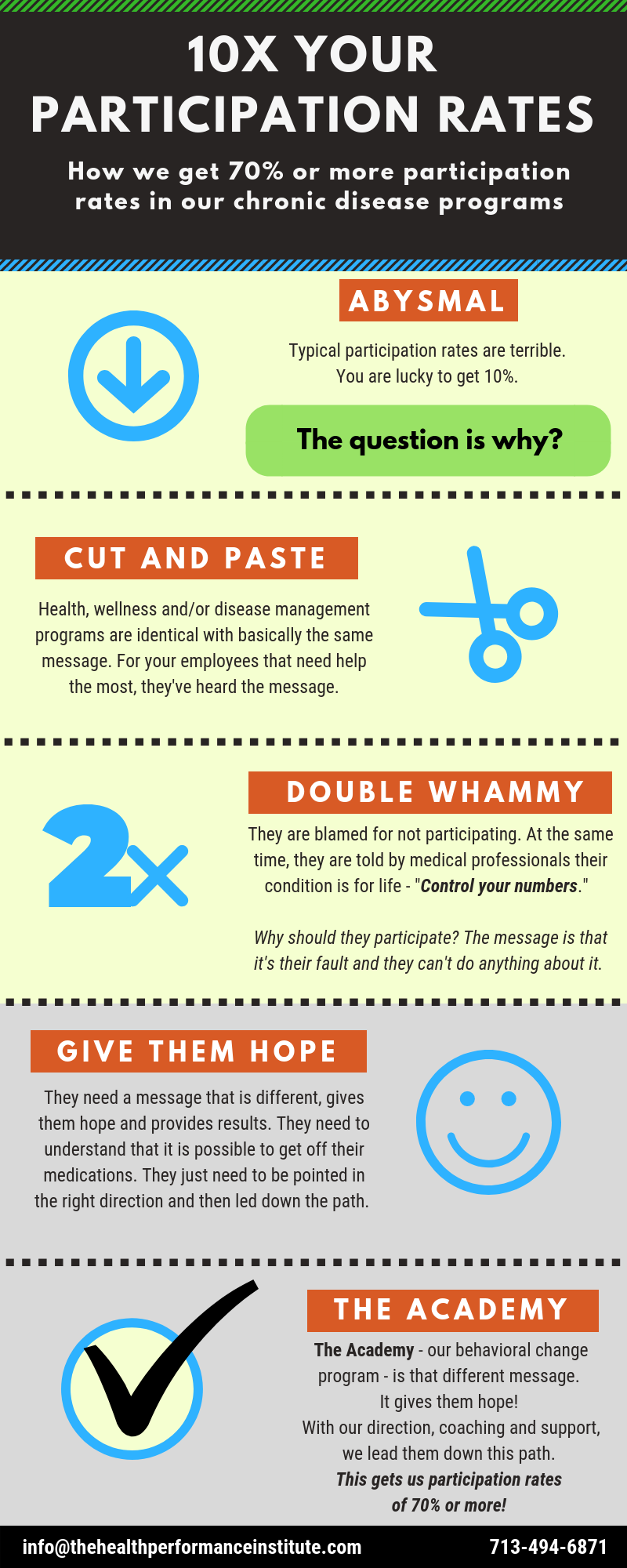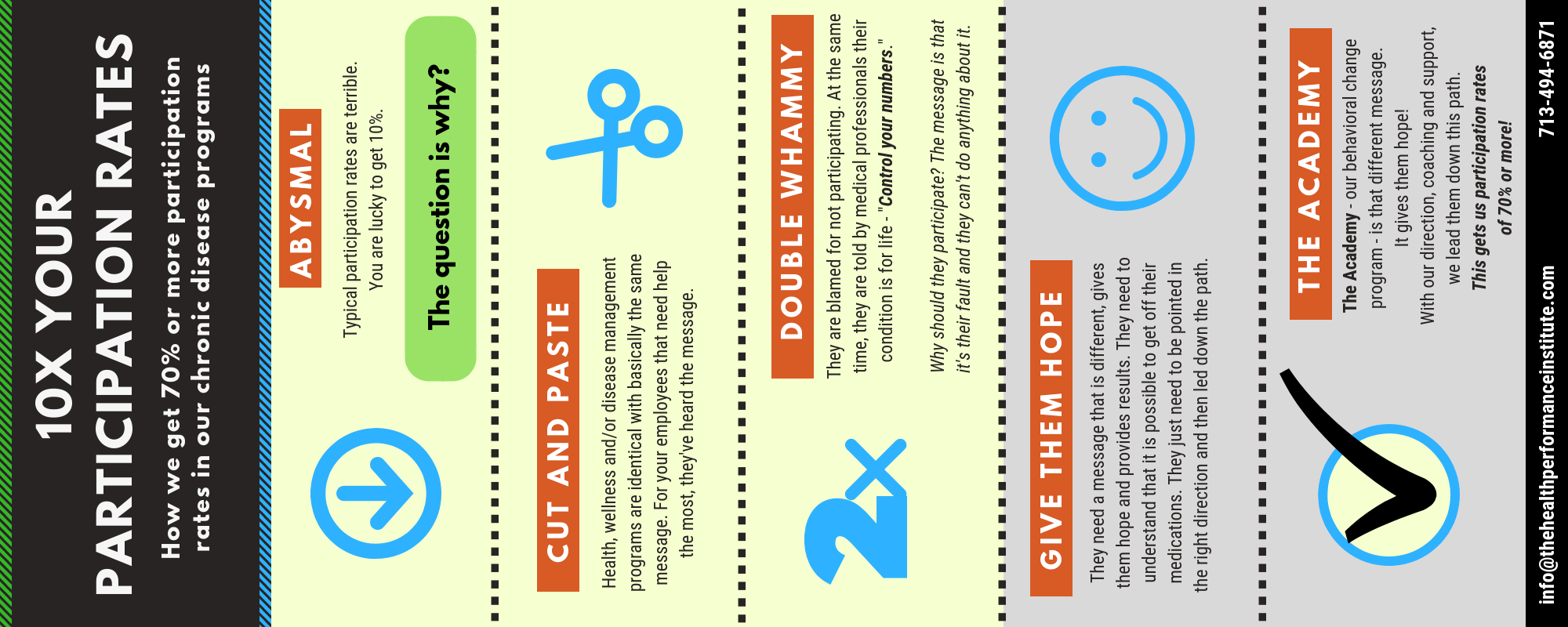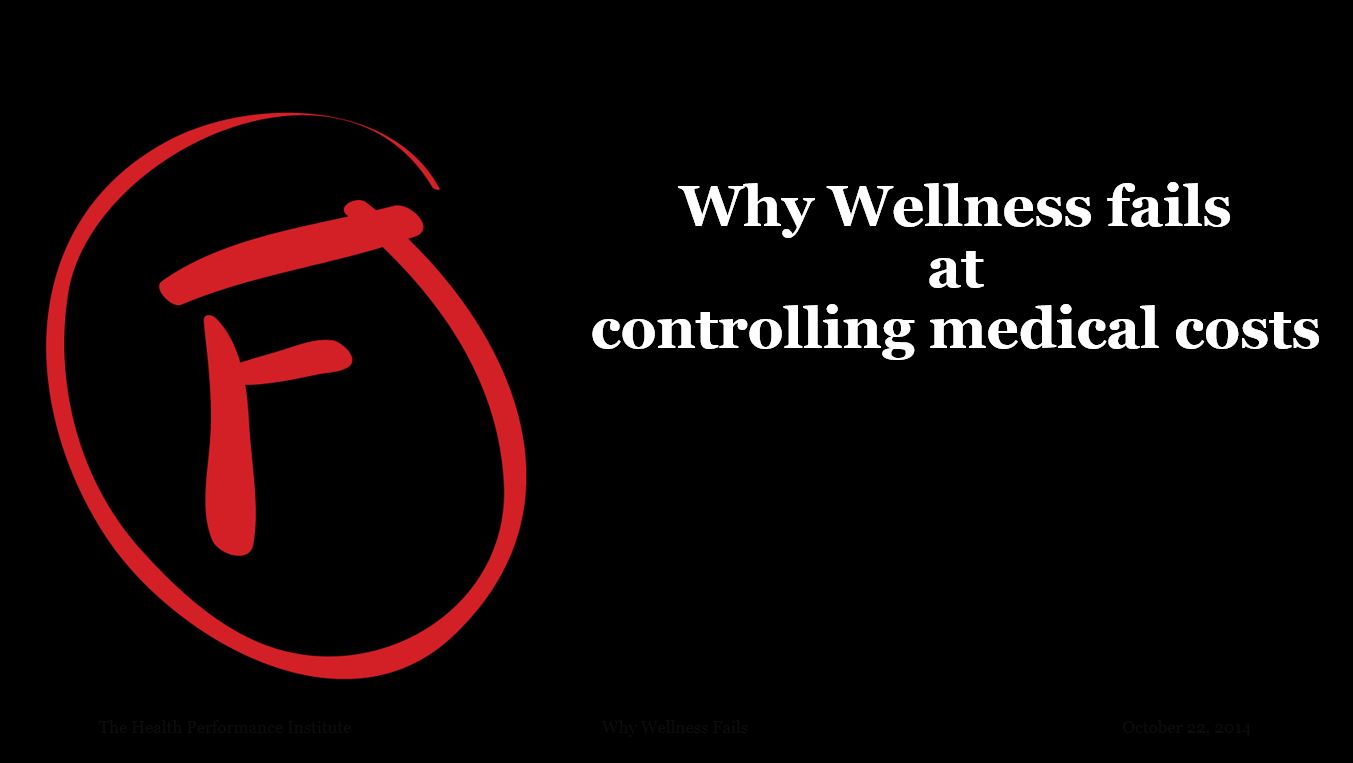How to 10X Your Disease Management and Wellness Program Engagement
If you are lucky to get 10% engagement, then continue reading
Why we do what we do
If you know anything about us, you know that helping people with chronic conditions is what we do best. More specifically, however, type 2 diabetes is our daily obsession.
In a nutshell: The treatment paradigm is off-target and the standard approach to prevention and/or wellness leaves a lot to be desired, which means those with chronic conditions suffer in a wasteland of co-morbidities, expensive remedies and a decreasing quality of life.
This type 2 diabetes obsession we have starts at the top, with Brian. His mom suffered horribly with type 2 diabetes. It’s not just his mom, however, as most with type 2 diabetes struggle as they get older. He’s convinced it doesn’t have to be this way and the thousands we have helped show this.
So…if you are in employee benefits (in any capacity), this is for you. In this post, you will learn why the programs you implement have such low engagement. You will also learn what you can do to fix it – how to get 10X engagement.
How Not to Engage Your Employees
This section could just have one sentence: Keep doing what you are doing.
But that isn’t helpful.
The question is WHY are your employees not engaging and how do you 10X your engagement?
One of Brian’s most popular talks is Why Wellness Fails. In this talk, he covers three reasons:
- Standard treatment protocols
- Cut-and-paste wellness/prevention programs
- The blame game
When you take all of this into account, it explains why engagement is low.
Standard Treatment Protocols are Off-target
Not only are they off-target, healthcare providers are notorious for setting their patients up for a lifetime of prescription drug dependency.
Off-target – using type 2 diabetes as an example – prescription drugs are targeted at controlling blood sugar. This is fine, as chronically elevated blood sugar increases risk for many things, however, in this case, elevated blood sugar is a symptom of the condition. Insulin resistance is the cause of elevated blood sugar, but little to nothing is done to address this.
So blood sugar continues to elevate, requiring medication to control it. However, over time, insulin resistance gets worse, leading patients to need additional (usually stronger or at least different) prescription medication.
And the icing on the cake: When people are diagnosed with type 2 diabetes, they are consistently told that the condition is for life, that it’s progressive and the only thing they can really do is to control their numbers with medication. Talk about your negative, lifelong, self-fulfilling prophecy!
Is it any wonder, then, that those with chronic conditions are less-than-motivated to do something about their health?
Cut-and-Paste Programs
Nearly all programs have the same message. All books on health, wellness, weight loss, etc… say the same thing. All healthcare providers say the same thing. All magazines and media reports say the same thing. This message can also be found for FREE with a simple internet search.
Given this, why should your employees participate in any program you offer? It’s not like they don’t know what they are supposed to do, right?
That’s the thought process, but the typical overweight, type 2 diabetic didn’t just wake up this way yesterday. It’s been a long, slow process. And believe us, they’ve tried all of these methods and they know the message.
So what incentive do they have to participate?
The Blame Game
Not only is there a problem with cut-and-paste programs, we tend to blame them when they don’t participate or when they quit or when they don’t get results. Why would/should they expose themselves to that? They already feel bad enough. Why would they torture themselves even more?
When you offer programs to your employees that meet these criteria, you get low (really low) engagement. Just like the proverbial outcome for a type 2 diabetic doesn’t have to be expensive treatments, increased co-morbidities and a decreasing quality of life, the engagement numbers you realize can be high. Really high. Like 10X higher than they are now.
How to add a big fat zero to your engagement numbers
Now that we know the problem, what can we do to fix it?
You need to offer them programs that work. Programs that give them hope. Programs that aren’t cut-and-paste, ones the provide demonstrable outcomes and are sustainable for the long-term.
Take type 2 diabetes as an example.
What would be some good outcomes for a type 2 diabetes program (at least as far as you’re concerned)? Maybe something like this:
- A decrease in prescription medication usage
- A positive change in the progression from pre-diabetes to diagnosis
- Maybe a shift from more expensive drugs to less expensive (or even generic)
All of these outcomes would indicate a change in the health status of your participants. This is something you’d want. It’s also indicative of a program that meets the above criteria.
Something like this would 10X your engagement – or add a big fat zero to the 6, 7 or 8% you currently see!
Our Engagement is HIGH
You can get these kind of engagement numbers with a program like The Academy. We use it and it’s exactly what we see – engagement rates of 70%, which usually end up higher over time because of our outcomes.
Is there some kind of magic wand in The Academy?
Magic wand? No.
But at its core, it has been developed around what works for the human body and the reasons engagement is low.
For example, in type 2 diabetics, the objective of The Academy is to improve insulin sensitivity. This helps control blood sugar naturally, which decreases reliance on prescription medication.
Additionally, we give them hope. We understand what they are going through and the frustrations they experience. Our core message to them is that THEY CAN get off their medication. But…they have to do things differently (Something most inherently understand because following directions hasn’t provided much hope). We teach them what to do, coach them up on how to do it and lead them down this path.
When you give people hope and let them know they can do something, they start believing it. Just as they believe their condition is progressive and for the rest of their life, the exact opposite is true. If they know what is possible, know how to do it and then see positive outcomes, they have hope. This is our job. It’s what we do and we love doing it.
When you approach it this way and apply these principles, it’s how you will 10X your engagement!
And we will finish this up with a side note: You should do this sooner, not later. Not when it’s convenient for your schedule, timing or work cycle. Healthcare costs are ridiculously out of control and the longer you wait, the more expensive it will be.
download our infographic
This entire article is captured in our infographic, which can be downloaded by clicking the link below.
If you have any questions about this article, our infographic below or how we might be able to put our fees at risk with an engagement guarantee, please comment below or send us an email.

Download our infographic on this article




